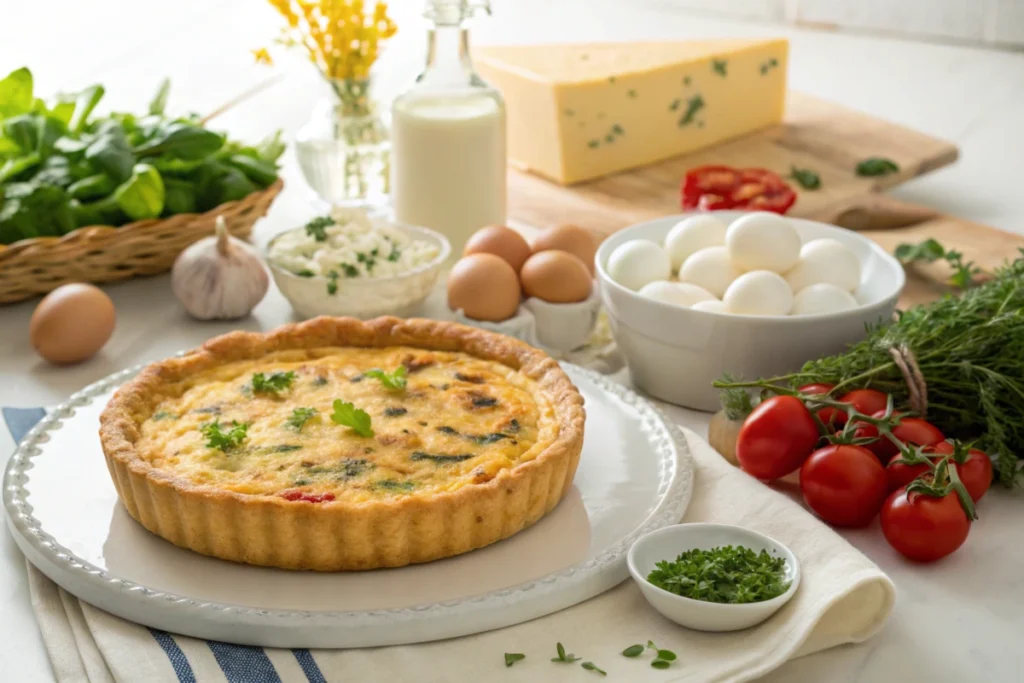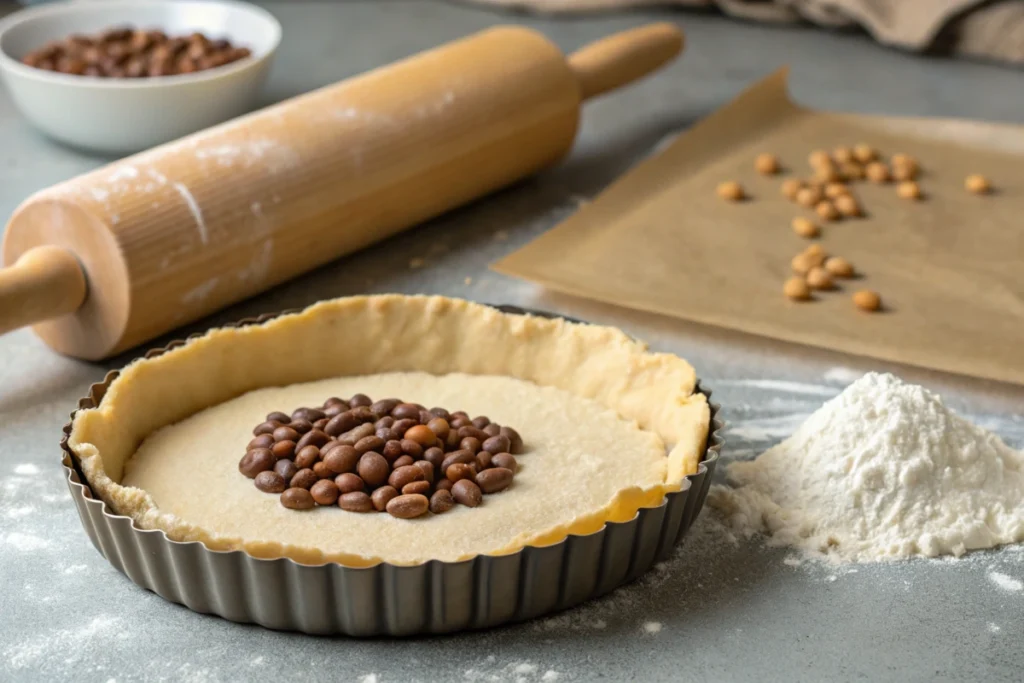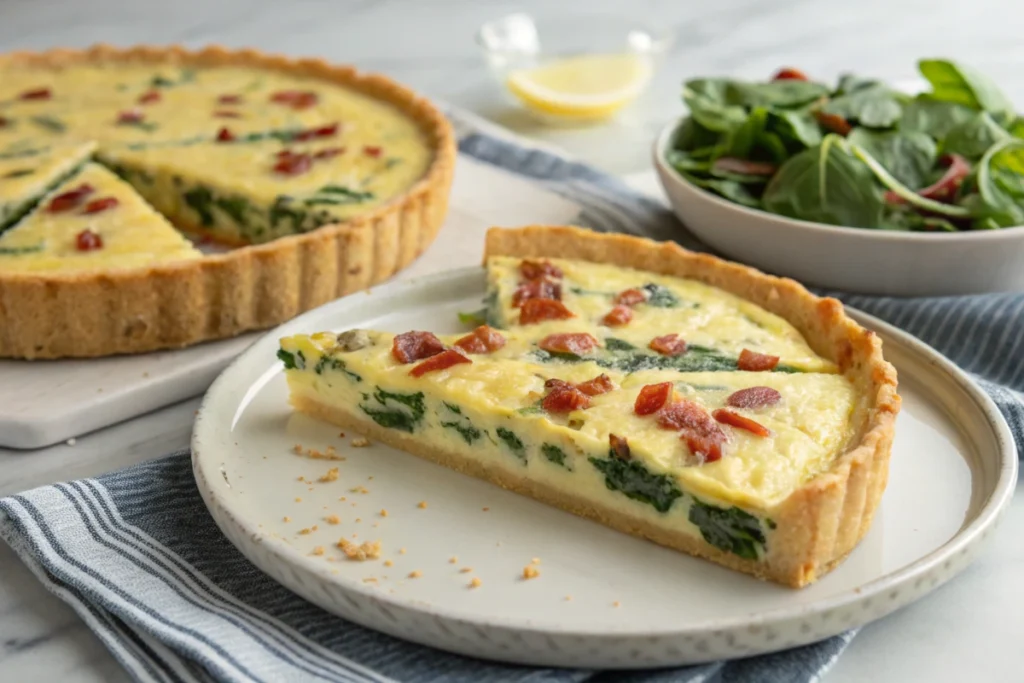
Quiche brings together simple ingredients to create an impressive dish that many people love. It works well for breakfast, brunch, or even a light dinner. The creamy filling and crisp crust combine soft and crunchy textures that people find hard to resist. But what makes an amazing quiche stand out from an ordinary one? What steps can you take to make yours unforgettable?
The details are crucial for creating a great quiche. You need to choose the best ingredients, use the right techniques, and avoid common mistakes. In this guide, we’ll explore everything you need to know to prepare a delicious and foolproof quiche. From its history to unique variations and troubleshooting tips, this article will help you master the art of quiche.
Are you ready to start making quiches everyone will rave about? Let’s dive into the secrets of creating this delightful dish!
Table of Contents
Part 2: Understanding the Basics of a Good Quiche
A good quiche is all about balance—balancing the textures, flavors, and the right combination of ingredients. Before diving into the techniques and tricks, it’s important to understand what makes a quiche truly exceptional.
What Defines a Good Quiche?
A truly great quiche has three standout features:
- A Buttery, Crisp Crust: The crust should hold the filling without being soggy. It provides the essential crunch that perfectly balances the smooth custard.
- A Creamy and Light Filling: The custard (a mix of eggs and cream) should be rich but not overly dense. The texture must be silky and well-set, not rubbery or too firm.
- Balanced Flavors: Each bite should bring together the savory custard, the flavorful mix-ins (like cheese, vegetables, or meats), and the crust. If the flavors clash or the textures feel off, the dish won’t taste right.
Historical Roots of the Quiche
Did you know that quiche originated in France, but its early history goes back even further? Interestingly, the word “quiche” comes from the German word kuchen, which means “cake.” Quiche Lorraine, the most traditional version, began in the Lorraine region of France. Initially, this classic recipe contained only eggs, cream, and bacon—no cheese!
Over time, however, French chefs began to innovate. They added cheese and experimented with other ingredients, including mushrooms, spinach, and seafood. As a result, quiche evolved into a versatile dish that’s now loved worldwide.
Why is a Quiche So Versatile?
Quiche works for any meal because it is:
Diet-Friendly: With gluten-free crusts or plant-based fillings, quiche easily adapts to dietary preferences. As a result, everyone can enjoy it, no matter their restrictions.
Customizable: You can fill it with almost anything—vegetables, meats, cheeses, or even leftovers. For instance, it’s a great way to use up extra ingredients from your fridge.
Easy to Prepare Ahead: You can make it in advance and serve it warm, at room temperature, or even cold. Therefore, it’s perfect for gatherings or meal prepping.
Part 3: The Secret Ingredients for Success

To create a great quiche, you need the right ingredients. While a quiche allows room for creativity, there are key components you can’t afford to overlook. Let’s dive into what makes the crust, filling, and fresh ingredients so important.
Choosing the Perfect Crust
The crust forms the foundation of your quiche, and it’s critical to get it right. A flaky, buttery crust adds texture and holds everything together. Here’s how to ensure your crust turns out perfectly:
- Use Shortcrust Pastry: Most traditional quiche recipes call for shortcrust pastry. This type of dough is rich and crumbly, making it ideal for a savory dish.
- Pre-Bake the Crust: Blind-baking, or pre-baking the crust, prevents sogginess. Simply line the dough with parchment paper, fill it with baking beans, and bake until golden.
- Experiment with Alternatives: For those who prefer something different, try using puff pastry, phyllo dough, or even a gluten-free crust. These options can bring a unique twist to your quiche while catering to specific dietary needs.
Balancing the Filling
The filling is the heart of any quiche, and getting the right balance between eggs, cream, and mix-ins is essential. Here are some tips:
- Perfect the Egg-to-Cream Ratio: The classic formula is one part egg to two parts cream. For example, use four eggs with one cup of cream for a standard 9-inch quiche. This ratio creates a creamy and smooth custard that holds its shape.
- Choose the Right Cheese: Gruyère, cheddar, or goat cheese are excellent choices for adding richness and flavor. However, avoid using overly moist cheeses like fresh mozzarella, as they can make the filling watery.
- Layer the Ingredients: Spread the heavier ingredients (like vegetables or meats) evenly over the crust before pouring the custard. This ensures every bite has a balance of flavors.
Using Fresh and Seasonal Ingredients
Fresh ingredients make a huge difference in the flavor and texture of your quiche. Whenever possible, use seasonal produce and high-quality proteins. For example:
- Vegetables: Spinach, mushrooms, zucchini, and roasted red peppers work wonderfully. Be sure to sauté or roast them beforehand to remove excess moisture.
- Proteins: Cooked bacon, ham, smoked salmon, or even shredded chicken add depth and substance to your dish.
- Herbs and Spices: Don’t forget fresh herbs like thyme, parsley, or chives. These subtle additions enhance the flavors and elevate your quiche to a new level.
Putting It All Together
Once you have your crust, custard, and mix-ins prepared, it’s time to assemble your quiche. Here’s a quick step-by-step:
- Preheat the oven to 375°F (190°C).
- Place your blind-baked crust on a baking sheet.
- Layer the mix-ins evenly in the crust.
- Pour the custard mixture gently over the ingredients, ensuring it spreads evenly.
- Bake for 30–40 minutes or until the custard is just set in the middle.
Part 4: Techniques That Elevate Your Quiche
Mastering the art of quiche goes beyond just picking the right ingredients. The techniques you use during preparation can transform an average quiche into a show-stopping dish. Let’s uncover the methods that make all the difference.
Pre-Baking for Perfection
One of the most common mistakes in quiche-making is skipping the pre-baking process for the crust. Here’s why blind-baking is crucial:
- Prevents Sogginess: Without blind-baking, the crust may absorb moisture from the custard, resulting in a soggy bottom.
- Improves Texture: A pre-baked crust develops a golden-brown color and crisp texture, providing the perfect contrast to the creamy filling.
- Allows Even Cooking: By partially cooking the crust before adding the filling, you ensure the entire quiche cooks evenly.
To blind-bake:
- Roll out your dough and fit it into your tart pan.
- Prick the base lightly with a fork to prevent air bubbles.
- Line the crust with parchment paper and fill it with baking beans or rice.
- Bake at 375°F (190°C) for 15–20 minutes, then remove the weights and bake for another 5 minutes.
Achieving a Creamy Custard
The custard, the focal point of any quiche, requires precise consistency. Follow these tips to ensure your custard comes out perfectly every time:
- Avoid Overbeating: Gently whisk the eggs and cream until just combined. Overbeating introduces too much air, which can lead to a spongy texture.
- Bake Low and Slow: Cooking your quiche at a moderate temperature (around 350–375°F) allows the custard to set gently without overcooking.
- Check for Doneness: The quiche is ready when the edges are set, but the center still jiggles slightly. It will continue to cook as it cools, resulting in a perfectly creamy texture.
Distributing Ingredients Evenly
Have you ever bitten into a quiche and found one side loaded with filling while the other feels empty? To avoid this, try these tricks:
- Layer Thoughtfully: Place heavier ingredients, like cooked vegetables or meats, in a single layer on the bottom of the crust. Add cheese on top to prevent it from sinking.
- Mix Lightly: Stir the custard and ingredients gently to avoid overmixing. A quick stir ensures even distribution without breaking the texture.
Timing is Everything
The timing of each step plays a significant role in quiche success. For example:
- Let your dough rest in the fridge for at least 30 minutes before rolling it out. This prevents shrinkage during baking.
- Allow your quiche to cool for 10–15 minutes after baking. This resting period helps the custard set completely and makes slicing easier.

Part 5: Common Mistakes to Avoid and Creative Variations
Even seasoned cooks can run into trouble when making a quiche. Luckily, most issues are easy to fix once you know what to watch out for. After we tackle these pitfalls, we’ll explore some exciting ways to get creative with your quiche recipes.
Common Mistakes to Avoid
Overloading the Quiche
While it’s tempting to pack your quiche with as many ingredients as possible, less is often more. Adding too many mix-ins can overwhelm the custard and cause the filling to spill over. Instead:
- Use no more than 1–1.5 cups of total mix-ins for a standard 9-inch quiche.
- Avoid watery ingredients like raw tomatoes or unblanched spinach.
Skipping Essential Steps
Skipping key steps like chilling the dough or pre-baking the crust can ruin the final product. Always:
- Chill your dough before rolling it out. This helps the crust stay firm and flaky.
- Blind-bake the crust to avoid a soggy bottom, as mentioned earlier.
Underestimating Cooking Time
A common mistake is removing the quiche from the oven too soon. If the center is still liquid, the custard will not set properly. On the other hand, leaving it in for too long can result in an overcooked, rubbery texture.
- Check your quiche 5 minutes before the recommended baking time. A toothpick inserted near the center should come out clean but slightly moist.
Unique Twists and Variations
Once you’ve mastered the basics, the possibilities for quiche are endless. Let’s explore some creative ways to make your dish stand out.
Regional Variations
Quiche recipes from around the world bring a new spin to the classic:
- Quiche Lorraine: The traditional French favorite, made with bacon and cream.
- Mediterranean Quiche: Includes sun-dried tomatoes, olives, feta cheese, and spinach for bold, savory flavors.
- Asian-Inspired Quiche: Uses ingredients like sesame oil, soy sauce, and sautéed mushrooms for a fusion twist.
Experimenting with Flavor Profiles
Who says quiche has to be savory? Try experimenting with different flavor profiles:
- Sweet Quiche: Use mascarpone cheese, honey, and fresh fruit for a dessert-style quiche.
- Spicy Quiche: Add chili flakes, jalapeños, or hot sausage for a fiery kick.
- Herb-Infused Quiche: Blend fresh herbs like dill, basil, or cilantro into the custard for a fragrant touch.
Alternative Ingredients
Quiche is incredibly versatile, making it easy to adapt to different diets:
- Gluten-Free Crusts: Use almond flour or a potato crust for a gluten-free option.
- Plant-Based Fillings: Replace eggs with a mix of silken tofu and nutritional yeast for a vegan version.
- Low-Carb Options: Skip the crust altogether and bake your quiche directly in a greased pan or silicone molds.
Serving Suggestions
Pair your quiche with simple sides to create a balanced meal:
- A crisp green salad with a light vinaigrette.
- Freshly baked bread or a croissant for added texture.
- A chilled glass of white wine or a hot cup of coffee, depending on the occasion.
Conclusion
Crafting an exceptional quiche requires both artistic and scientific skills. By understanding the basics, perfecting your techniques, and experimenting with creative variations, you can transform this humble dish into something extraordinary. Remember to start with high-quality ingredients, follow essential steps like pre-baking, and take your time to achieve the perfect balance of flavors and textures.
Now it’s your turn to try these tips in your kitchen. With a little practice, you’ll become the go-to quiche maker in your circle!
